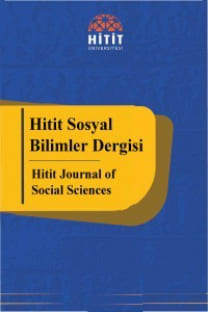ÇEVİRİBİLİMİNDE THEO HERMANS BAĞLAMINDA DİZGE ODAKLI BİR YAKLAŞIM
Çeviride dizge odaklı yaklaşım denildiğinde akla ilk gelen isimlerden biri Çoğuldizge (Polysystem) Kuramı ile bilinen Itamar Even-Zohar’dır. Bununla birlikte, Belçikalı çeviribilimci Theo Hermans 1999’da yayımlanan Translation in Systems adlı eseriyle çeviride dizge odaklı yaklaşımları irdeleyip dizge kavramını açımlayarak Alman sosyolog Niklas Luhmann’ın dizge yaklaşımını çeviribilime uyarlamasıyla farklı bir bakış açısı getirmiştir. Bu makalede, Hermans’ın çeviride seksenli yıllardan itibaren tartışılan dizgesel yaklaşımları nasıl değerlendirdiğini ve özelde çeviri sosyolojisi alanında sınırlı bir ilgiyle karşılanan Luhmann’ın dizge kuramının çeviribilim alanında neden ve nasıl kullanılabileceğine yönelik görüşleri ele alınmıştır. Bu bağlamda, Hermans’ın Çoğuldizge Kuramı’nı hangi açılardan eleştirdiği ve söz konusu kuramdaki kavramsal yaklaşımları nasıl sorguladığı dile getirilmiştir. Çalışmada ayrıca, çeviribiliminde sosyolojiden aktarılan bazı kavramların çeviribilimine nasıl yansıdığı ve bunun çeviri biliminin sınırlarını nasıl genişlettiği irdelenmiştir. Dolayısıyla disiplinler arası ilişkilere açık bir alan olan çeviribilimin sosyolojiden nasıl etkilendiği Luhmann’ın kuramı çerçevesinde tartışılmıştır.
Anahtar Kelimeler:
Theo Hermans, dizgesel yaklaşımlar, Niklas Luhmann, çeviri sosyolojisi, Çoğuldizge
A System-oriented Approach in Theo Hermans’ Context in Translation Studies
When it comes to system-oriented approaches to translation studies, the first name coming to mind is usually Itamar Even-Zohar with his poly-system theory. On the other hand, Theo Hermans did not only analyse system-oriented approaches to translation studies in his book Translation in Systems but he also offered a different point of view for translation studies by applying systems theory of German sociologist Niklas Luhmann to issues of translation. This article aims at studying Hermans’ criticism and interpretation of previous systemic approaches and his opinions in the aforesaid book on why and how Luhmann’s systems theory, which has actually been of limited concern in the filed of sociology of translation, can be utilised in translation studies. In this context, Hermans’ criticism of poly-system theory and his views about the drawbacks of the mentioned theory will be examined. It will also be scrutinised how the terms borrowed from sociology are reflected to the study of translation and how far they spanned the boundaries of the translation studies. Hence, the effects of sociology on translation studies, as a field open to interdisciplinary relations, will be argued within the framework of Luhmann’s systems theory.
Keywords:
Theo Hermans, system-oriented approaches, Niklas Luhmann, sociology of translation, Polysystem,
___
- Arı, S. (2014). Çeviri Sosyolojisi. İstanbul: Aylak Adam Yayınları.
- Arı, S. ve Tosun, M. (2018). Sosyal Sistem Kuramı ve sosyal sistem olarak çeviri. International Journal of Languages’ Education and Teaching 6, 488-495. doi:10.18298/ijlet.2632
- Bourdieu, P. (1977). Outline of a theory of practice. R. Nice (Çev.). London: Polity.
- Cankurtaran Öntaş, Ö. ve Akçay, S. (2014). Niklas Luhmann’ın sistem teorisi ve teorinin sosyal hizmet disiplinindeki yansımaları. Toplum ve Sosyal Hizmet 25(2), 97-110. Erişim adresi: https://dergipark.org.tr/tr/download/article-file/797823
- Derrida, J. (1994). Göstergebilim ve Gramatoloji. T. Akşin (Çev.). İstanbul: Afa Yayınları.
- Even-Zohar, I. (1990). Polysystem studies, poetics today 11(1), özel sayı. Durham: Duke University Press.
- Hermans, T. (1985). The manipulation of literature: studies in literary translation. London/Sydney: Croom Helm.
- Hermans, T. (1998). Translation and Normativity. Current Issues in Language & Society 5, 51-72. doi: 10.1080/13520529809615503
- Hermans, T. (1999). Translation in systems: descriptive and systematic approaches explained. Manchester: St Jerome.
- Hermans, T. (2002). The production and reproduction of translation: systems theory and historical context. S.
- Paker (Ed.). Translations: (re)shaping of literature and culture içinde (s. 175-194). İstanbul: Boğaziçi University Press.
- Lefevere, A. (1992). Translation, rewriting and the manipulation of literary fame. Londra and New York: Routledge.
- Levy, J. (1969). Die literarische Übersetzung. Theorie einer Kunstgattung (W. Schamschula, Übers.). Franfurt a. M. u. Bonn: Athenaeum.
- Luhmann, N. (2013). Introduction to systems theory. Cambridge: Polity.
- Munday, J. (2008). Introducing translation studies: Theories and applications. London ve New York: Routledge.
- Popovic, A. (1976). Aspects of metatext. Canadian Review of Comparative Literature 3, 225-235. Erişim adresi: https://journals.library.ualberta.ca/crcl/index.php/crcl/article/view/ 2290
- Seguinot, C. (2000). Compte rendu de [theo hermans. translation in systems. descriptive and system-oriented approaches explained]. TTR: Traduction, Terminologie, Rédaction 13(1), 198-202. doi: 10.7202/004297ar
- Simeoni, D. (1998). The pivotal status of the trasnlator’s habitus. Target 10, 1-39. doi: 10.1075/target.10.1.02sim Snell-Hornby, M. (2006). The turns of translation studies. New paradigms or shifting viewpoints? Amsterdam/Philadelphia: John Benjamins Publishing Company.
- Stolze, R. (2013). Çeviri kuramları. E. Durukan (Çev.). İstanbul: Değişim Yayınları.
- Tahir-Gürçağlar, Ş. (2011). Çevirinin ABC'si. İstanbul: Say Yayınları.
- Toury, G. (1995). Descriptive translation studies and beyond. Amsterdam/Philadelpiha: John Benjamins Publishing Company.
- Wolf, M. (2007). Introduction: The emergence of a socialogy of translation. M. Wolf and A. Fukari (Eds.). Constructing a Sociology of Translation içinde (s. 1-38) Amsterdam/Philadelphia: John Benjamins Publishing Company.
- Yayın Aralığı: Yılda 2 Sayı
- Başlangıç: 2008
- Yayıncı: Hitit Üniversitesi
Sayıdaki Diğer Makaleler
ENTEGRE RAPORLAMAYA UYGUNLUĞU AÇISINDAN KATILIM BANKALARININ FAALİYET RAPORLARININ İNCELENMESİ
Ahmet ALKOYUN, Emre Selçuk SARI
PARTİ SİYASETİNDEN İTTİFAK SİYASETİNE
HİZMET HATASI, HİZMET TELAFİSİ VE ATIF TEORİSİ: KAVRAMSAL BİR ÇALIŞMA
Selman TEMİZ, Ramazan KURTOĞLU
ÇEVİRİBİLİMİNDE THEO HERMANS BAĞLAMINDA DİZGE ODAKLI BİR YAKLAŞIM
ULUSAL KÜLTÜR BOYUTLARININ İŞLETMELERİN KURUMSAL SOSYAL SORUMLULUK ÇALIŞMALARINA ETKİSİ
YATIRIMCI RİSK TOLERANSI VE PİYASA LİKİDİTESİ İLİŞKİSİ: SEÇİLİ PİYASALARDAN BULGULAR
İŞ TATMİNİNİN GİRİŞİMCİLİK EĞİLİMLERİ ÜZERİNDEKİ ETKİSİNDE DÖNÜŞÜMCÜ LİDERLİĞİN ARACILIK ROLÜ
TÜRKİYE’DE TARIMSAL VERİMLİLİK VE ALAN BAZLI DESTEKLEMELER ÜZERİNE AMPİRİK BİR UYGULAMA
